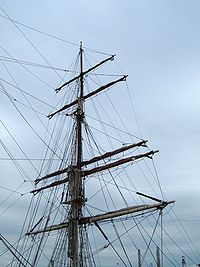Elissa (ship)
| 200px | |
| Career (United Kingdom, Norway, Sweden, United States) | |
|---|---|
| Name: | Elissa |
| General characteristics | |
| Displacement: | 620 tons. |
| Length: | 141 ft (43 m) |
| Beam: | 28 ft (8.5 m) |
| Draft: | 10 ft 6 in (3.20 m) . |
| Capacity: | 430 tons cargo |
| ELISSA | |
|---|---|
| U.S. National Register of Historic Places | |
| U.S. National Historic Landmark | |
| Location: | Galveston, Texas |
| Coordinates: | 29°18′34″N 94°47′37″W / 29.30943°N 94.793601°WCoordinates: 29°18′34″N 94°47′37″W / 29.30943°N 94.793601°W |
| Built/Founded: | 1877 |
| Architect: | Alexander Hall & Sons |
| Architectural style(s): | Three-masted Barque |
| Added to NRHP: | March 21, 1978[1] |
| Designated NHL: | December 14, 1990[2] |
| NRHP Reference#: | 78002930 |
The tall ship Elissa is a three-masted barque. She is currently moored in Galveston, Texas, and is one of the oldest ships sailing today.
The Elissa was built in Aberdeen, Scotland as a merchant vessel in a time when steamships were overtaking sailing ships. She was originally launched on October 27, 1877. According to the descendants of Henry Fowler Watt, the Elissa's builder, she was named for the Queen of Carthage, Elissa (more commonly called Dido), Aeneas' tragic lover in the epic poem The Aeneid.
The Elissa also sailed under Norwegian and Swedish flags. In Norway she was known as the Fjeld of Tønsberg and her master was Captain Herman Andersen. In Sweden her name was Gustav of Gothenburg.
The Elissa has an iron hull, and the pin rail and bright work is made of teak. Her masts are made of Douglas fir from Oregon, and her 19 sails were made in Maine. She has survived numerous modifications including installation of an engine, and the incremental removal of all her rigging and masts.
The Elissa was rescued from destruction by ship preservationists who found her languishing in a salvage yard in Piraeus, Greece. She was purchased for $40,000, in 1975, by the Galveston Historical Foundation, her current owners. In 1979, after a year in Greece having repairs done to her hull, the Elissa was towed to Galveston. There the restoration process continued.
The Elissa made her first voyage as a restored sailing ship in 1985, traveling to Corpus Christi, Texas. A year later, she sailed to New York City to take part in the Statue of Liberty's centennial celebrations.
When she's not sailing, the Elissa is moored at the Texas Seaport Museum in Galveston. Public tours are available year-round-provided she is not out sailing. The ship is sailed and maintained by qualified volunteers, who come from various places in East Texas.
Honors
- National Register of Historic Places - first object granted this status while outside United States territory
- National Historic Landmark
- Named state Tall Ship by act of legislature in 2005[3]
- Designated one of "America's Treasures" by the National Trust for Historic Preservation
- Escorted the Texas (SSN-775) into Galveston harbor to be commissioned
References
- ↑ "National Register Information System". National Register of Historic Places. National Park Service. 2009-03-13. http://www.nr.nps.gov/.
- ↑ "Elissa (Bark)". National Historic Landmark summary listing. National Park Service. http://tps.cr.nps.gov/nhl/detail.cfm?ResourceId=1794&ResourceType=Structure. Retrieved 2009-07-03.
- ↑ State symbols, Texas State Library, http://www.tsl.state.tx.us/ref/abouttx/symbols.html
External links
| ||||||||||
| |||||
- Pages using duplicate arguments in template calls
- Pages with broken file links
- Barques
- Museum ships in Texas
- Individual sailing vessels
- Culture of Galveston, Texas
- Tall ships of the United States
- Sailing ships of the United States
- National Historic Landmarks in Texas
- Ships on the National Register of Historic Places
- Museums in Galveston, Texas

